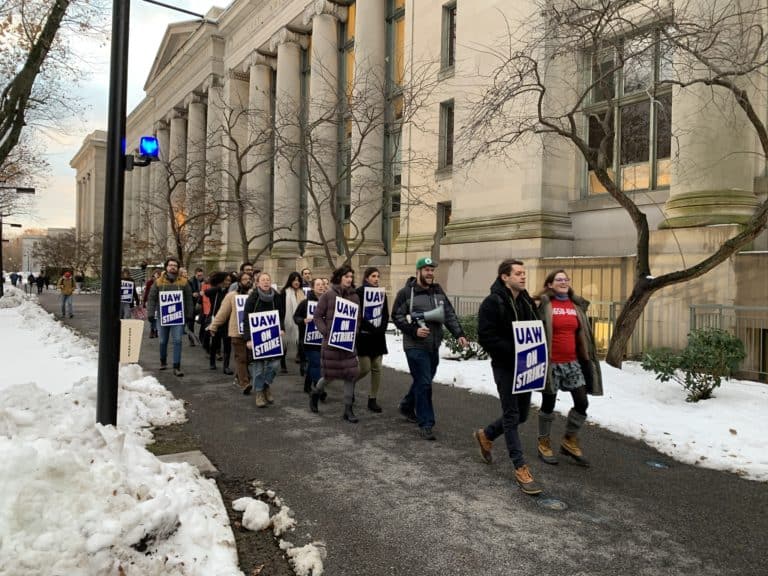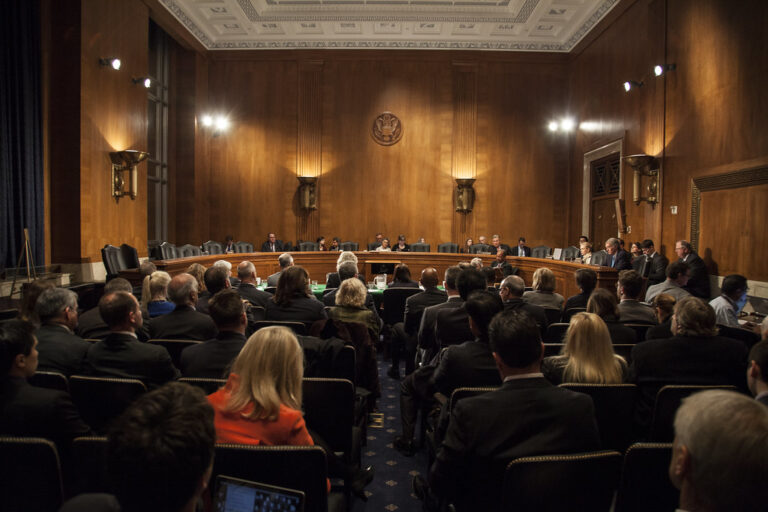On Friday, the House of Representatives “effectively scuttled legislation granting the president trade promotion authority” to negotiate the Trans-Pacific Partnership on a fast-track basis, according to the New York Times. Democrats voted overwhelmingly against Trade Adjustment Assistance, a program that the party and the labor movement have long supported as a means of helping workers displaced by trade. Advocates of the fast-track measure combined the trade and worker initiatives as a package deal to draw bipartisan support. Without the passage of the worker assistance program, the trade initiative appears unlikely to pass the Senate.
At the Washington Post, Lidia DePillis dissected this development, characterizing it as “a significant triumph for the unions” on “one of the biggest fights organized labor has picked after years and years of declining influence and legislative defeat.” DePillis attributed success to the broad coalition that labor forged on the issue, drawing in “environmental, faith, immigrant, Internet openness, human rights, community, and progressive groups” and taking advantage of conservative skepticism of the president. The coalition effort is emblematic of the AFL-CIO’s big tent strategy to achieve victories that it can no longer attain on its own. House leadership still plans to move forward with the trade bill, but it seems unlikely to succeed without greater concessions to labor priorities. The New York Times also provided an in-depth analysis of labor’s early and sustained efforts to derail the legislation.
The clash between the Wisconsin labor movement and Governor Scott Walker provided the basis for an in-depth article in the New York Times Magazine anticipating the governor’s presidential campaign and nationwide efforts to replicate his anti-union successes nationwide. The piece highlighted Governor Walker’s “divide and conquer” strategy of attacking public-sector labor organizing rights in 2011 before passing the state’s right-to-work law earlier this year. Describing the Wisconsin campaign and hinting at the struggle to come, labor activist Randy Bryce stated that because the first union bill only targeted public workers, “A lot of guys in our local didn’t see Act 10 as being important for ironworkers . . . I would ask them, how can you say there are good unions and bad unions? It’s an idea that they’re trying to kill — it’s not the union itself. This is the strategy they’re using to do it. They’re splitting everything up. They’re going after them first, then it’s going to be somebody else. Then they’re going to get to us too.”
The Los Angeles Times provided deeper analysis of the farmworkers’ organizing victory in Mexico previously covered on the blog. As a result of the bargaining, thousands of workers will see their wages rise by as much as 50%. Despite these claims, the article pointed out that enforcement of the agreement may be difficult if businesses engage in efforts to evade their obligations and the Mexican government proves ineffective at enforcing the agreement. Although movement leaders plan to replicate their victories across the country, it remains uncertain whether the unique advantages enjoyed by workers in Baja California are necessary for organizing success elsewhere in the country. In a bit of chest-puffing, the newspaper was quick to point out that labor leaders have partially attributed the victory to the international media attention the workers received in their organizing drive.
The organizing campaign at Gawker Media continues to draw coverage. The New York Times examined what will likely be the focus of the upcoming contract negotiations. The article contrasted the writers’ concerns with what it characterized as the concerns of your “grandfather’s” union, noting that the contract will likely focus on “the need for good severance pay; salary minimums for each position; annual meetings with supervisors to discuss performance, salary and promotions; and a bar against changes to the company health plans without union approval.”
The news earlier this month that Disney might have used H-1B visas to hire immigrants for lower wages than American workers appears to have drawn increasing scrutiny to the issue as the Department of Labor has begun an investigation into the practice at Southern California Edison, according to the New York Times.






Daily News & Commentary
Start your day with our roundup of the latest labor developments. See all
November 21
The “Big Three” record labels make a deal with an AI music streaming startup; 30 stores join the now week-old Starbucks Workers United strike; and the Mine Safety and Health Administration draws scrutiny over a recent worker death.
November 20
Law professors file brief in Slaughter; New York appeals court hears arguments about blog post firing; Senate committee delays consideration of NLRB nominee.
November 19
A federal judge blocks the Trump administration’s efforts to cancel the collective bargaining rights of workers at the U.S. Agency for Global Media; Representative Jared Golden secures 218 signatures for a bill that would repeal a Trump administration executive order stripping federal workers of their collective bargaining rights; and Dallas residents sue the City of Dallas in hopes of declaring hundreds of ordinances that ban bias against LGBTQ+ individuals void.
November 18
A federal judge pressed DOJ lawyers to define “illegal” DEI programs; Peco Foods prevails in ERISA challenge over 401(k) forfeitures; D.C. court restores collective bargaining rights for Voice of America workers; Rep. Jared Golden secures House vote on restoring federal workers' union rights.
November 17
Justices receive petition to resolve FLSA circuit split, vaccine religious discrimination plaintiffs lose ground, and NJ sues Amazon over misclassification.
November 16
Boeing workers in St. Louis end a 102-day strike, unionized Starbucks baristas launch a new strike, and Illinois seeks to expand protections for immigrant workers